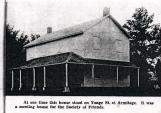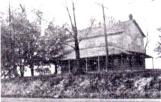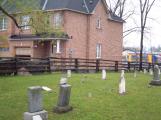2
Quakerism emphasizes human goodness because of a belief that something of God exists in everyone. Quakerism was a way of life. In 1829 there was a separation in the Society of Friends caused by a disagreement over doctrinal matters advocated by Elias Hicks, an american, from which arose the so-called Hicksite branch. It led to the building of a second meeting house a few rods south of the existing one.4
To the west in close proximity to the second meeting house was established a small burying ground which still exists on Yonge street.The names on the stones give some idea of the families lost to the main Quaker meeting, Armitage, Crone, Daniel, Dennis, Hollingshead, Hughes, Lloyd, Mathews and more.
5
Hicksite Meeting House, now demolished. Only cemetery stones left on site.1829
Yonge Street, south of Mulock Drive, Newmarket, Ontario

6
This Hicksite faction existed for many years afterwards. The meeting house was demolished in 1940s.8
Another conflict in the 1830s leading to the development of a sect called the "children of peace" in Sharon north-west of Newmarket was led by a David Wilson who wanted among other things an opportunity to add music and singing to the service.9
This led to the building of Sharon Temple and a number of followers from the Yonge Street Meeting going to the Children of Peace.11
Although this group persisted for many years the temple eventually was deserted and stood vacant for many years until it was saved from destruction by the York Pioneers Historical Society.12
The Sharon Temple is now a National Historic site. The Yonge Street Quaker Meeting still exists with a quite small congregation.So beside internal conflicts the Quakers in Newmarket were driven underground or out of the religion completely by persecution in the 1837 Rebellion, their resistance to bearing arms in any conflict, and their resistance to war at any level.
13
QUAKERS INTO THE MODERN ERAAfter the Hicksite split and the Willson split the Newmarket Quaker group became smaller and smaller. The families that left became more involved with other religious groups. The families that remained continued their very strict rules about marriage and conduct in the Yonge Street Meeting.
In the more modern era and because of the large families, not all of which could continued on the heritage farm, they became more involved with Newmarket and area commerce.



